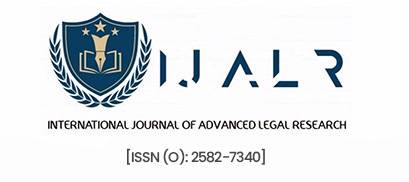ABSTRACT
Are there any provisions available to legal professionals working in the workplace? Or do they have any specific provision about the protection and redressal framework for female advocates? Although the Prevention of Sexual Harassment at the Workplace ensures the safety of women in the workplace, its applicability remains ambiguous and unsettled in the legal professional environment. Who falls under the domain of the Posh Act, and what is the employee-employer relationship or are advocates considered as the employees of the bar council? Are Independent practice or chambers deemed workplaces under the POSH Act? These pressing questions require clear answers backed by legal provisions. Try to understand statutory provisions, judicial interpretations and legal loopholes.
INTRODUCTION
Prevention of sexual harassment was enacted with the prevention of sexual harassment at the workplace; both have the common objective, which is to safeguard women from sexual harassment, inclusive of all forms of physical, verbal and non-verbal abuse. This Act was legislated to make sure women feel safe and respected at work workplace without being subjected to discrimination and intimidation.
- Section 2(a)defines the “aggrieved woman” as a woman of any age who has been sexually harassed at the workplace (Irrespective of whether she is employed or not, or in the house where she works (Like a domestic helper.[1]
- Section 2(g) defines the “Employer” as a person who is in charge of managing, supervising and controlling the workplace, which can be a government department, a private company, a firm or NGOs. Also, the person who is responsible for fulfilling the contract ( like paying salary or managing workers) and the household worker appointed by a person or family. [2]
- Section 2(o)defines the “Workplace” as a workplace where a woman works or is connected to her work. The place includes a government office, department or organization funded by the government, any private company, NGOs, a school, college, hospital, trust or business, sports places, a house where a domestic worker works, or any place where she may go for work.[3]
- Section 3explains that a woman should not be harassed in the workplace, which also includes the following circumstances that amount to sexual harassment.
- A promise of a promotion or special treatment in exchange for sexual favour.
- A threat of bad treatment if she refuses
- A threat to her current or future job
- Make the workplace scary, insulting and uncomfortable.
- Rude and insulting behaviour.[4]
- Section 9explains the procedure for filing complaints in the following sets: A woman who has been harassed at the workplace may go to the internal and local community.
- A complaint must be filed within 3 months of the date of the incident.
- A period of complaint can be extended to more than 3 months if she has a valid cause.
- A complaint must be written by any member of the committee on her behalf if she is unable to write.
- Her complaint can be filed by the legal heirs or an authorized person if she is mentally and physically challenged or has passed away.[5]
- Section 19explains the duties of the employer towards the victim of sexual harassment –
- Provide a safe workplace for women from outsiders or visitors, and insiders.
- Display crucial information such as the internal committee and punishment for the offender.
- Awareness and training programs.
- Provide support to committees.
- Help with witnesses.
- Share the required information, such as the document necessary for the complaint.
- Help in the legal action
- Take action against outsiders
- Treat harassment and monitor reports[6]
CASE ANALYSIS
In Vishakha v. State of Rajasthan, where Supreme Court gave a broader definition of sexual harassment and its scope. According to the Supreme Court of India, any unwanted sexual behaviour, directly or indirectly, which also includes :
- Direct or indirect sexual favours
- Touching someone badly, which makes her uncomfortable
- Showing pornography
- Any other form of sexual harassment[7]
Post Vishakha, there was a landmark ruling, Apparel Export v. A.K. Chopra, for the scope and definition of sexual harassment, which was explained as there is no fixed rule as such for unwanted or unwelcome sexual behaviour, whether it is done directly or indirectly, that hurts the modesty of the female worker. In the book named “Sexual harassment of Working Women”,written by MacKinnon,itexplains that there are two different types of sexual harassment, namely Quid pro Quo (sexual harassment for the job benefits ) and Hostile Work Environment ( where the workplace feels uncomfortable). [8]
The public interest litigation was filed by the UNS Women’s Legal Association,stating that there should be a permanent redressal committee for the advocates in all bar council offices, including the Bar Council of Maharashtra. This matter was heard by Justice Alok Aradhe and Justice Sandeep V. Marne, and they said that advocates do not fall within the ambit of the POSH ACT as there is no employer–employee relationship between the advocates and the Bar Council.
In the case of Amarendra Kumar Mohapatra v. State of Orissa (2014) court held that the title and context work differently; we should not rely on the title, but we should also understand the law as well. But in this case title and narrative match perfectly, which signifies the importance of the protection of all women within the workplace, whether they are working or not. This works differently from the US Civil Rights Act of 1964 ( Title VII), where sexual harassment is considered wrong only when it happens in the duration of employment.[9] In the case of Inclusive Foundation v. Union of India ( decided on 19 October 2023)[10]The Supreme Court repeated the direction inthe case.Aureliano Fernandes v. State of Goa[11]Said that there has to be an internal complaint committee to handle the sexual harassment issue, especially at nursing homes, sports institutes, stadiums and competition venues, and also emphasized para 77(iii), which includes professional bodies such as doctors, lawyers, architects, accountants, engineers, and bankers. Universities, colleges, training centers, educational institutes, government and private hospitals. Aureliano Fernandes case, the complaint was filed by the students, not by the employee, which shows equal protection for the students and other individuals.
Section 35 of the Advocates Act 1961[12]clarifies that disciplinary action can be taken by the disciplinary committee if the State Bar Council receives any complaint or suspects professional or other misconduct by an advocate, which also includes harassment of any form. However, the Bombay court cleared on this point,the POSH ACT is still applicable to the regular employees of the BCI and BCMG, including administrative staff and committee members. Women advocates are out of the scope of the Posh Act as there is no employer–employee relationship, but they may go to the internal committee of the Bar Council and report the sexual harassment of any form. [13] In the case of Women’s Legal Association vs Bar Council of India,[14]the petitioner was an association which is registered under the Societies Registration Act 1860. The association asked the court to formulate a permanent internal grievance committee for women lawyers at the State Bar Council and the Bar Council of Maharashtra. To support this proposal, the association relied on the case of Medha Kotwal Lele vs Union of India (2013), where the Supreme Court had already directed to formation of such a committee for the protection of female advocates, after passing of the Posh Act. The court examined sections 2(f), 2(g), 4 and 6 and observed that these provisions are only applicable when there is an employer and employee relationship, but advocates are not the employees of the Bar Council.[15]
[1] Prevention of sexual harassment Act, 2013, s 2(a)
[2]Prevention of sexual harassment Act, 2013, s 2(g)
[3] Prevention of sexual harassment Act, 2013, s 2(o)
[4]Prevention of sexual harassment Act, 2013, s 3
[5] Prevention of sexual harassment Act, 2013, s 9
[6]Prevention of sexual harassment Act, 2013, s 19
[7]Arushi Chopra, The Vishaka Guidelines: A step against sexual Harassment ( Ipleader, 2 March 2020 ) <https://share.google/eBZZrmFsAhRjUN4nS> accessed 25 July 2025.
[8]Nikunj Arora, POSH Act 2013 ( Ipleader, 11 July 2022) <https://share.google/HyVqo9RW77ZVlQO97> Accessed 25 July 2025
[9]Advocates are not Bar Council employees, hence outside the ambit of POSH Act: Bombay High Court ( SCC ONLINE, 17 July 2025) <https://share.google/8OU3sEzsTR7AMI4xj> Accessed 26 July 2025.
[10]Inclusive Foundation v. Union of India, 2024(I)CLR288
[11]CIVIL APPEAL NO. 2482 of 2014
[12]Advocates Act 1961, s 35
[13]Advocates are not Bar Council employees, hence outside the ambit of POSH Act: Bombay High Court ( SCC ONLINE, 17 July 2025) <https://share.google/8OU3sEzsTR7AMI4xj> Accessed 26 July 2025.
[14]Women’s Legal Association vs Bar Council of India, 2025 SCC OnLine Bom 2647
[15]Medha Kotwal Lele vs Union of India (2013), AIRONLINE 2012 SC 632

